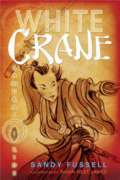
Samurai Kids Book 1: White Crane
Written by Sandy Fussell
Illustrated by Rhian Nest James
Walker Books, Australia, 2008, 245 pp.
ISBN: 978-1921150203
This historical fiction novel tells the story of Niya Moto, a samurai boy with one leg in feudal Japan, and his four fellow students who also have disabilities; one is missing an arm, one is blind, and another has extra fingers and toes. Niya’s own words “We’re the unwanted. Unwanted everywhere else” (p. 14) indicate how prejudice has dominated their lives. One samurai school, Cockroach Ryu, which is led by the legendary samurai master Ki-Yaga, accepts the students and slowly changes their lives by giving them hope and helping them achieve success. Ki-Yaga teaches them Bushido (the samurai code) including “Chi, Jin, Yu (wisdom, benevolence, courage)” through lessons that include sword fighting, wrestling, archery, calligraphy, origami, and haiku poetry. The teacher also helps the students find their own talents and spirit totems. For example, Niya’s totem is a White Crane because he is good at standing on one leg and his strength is archery, which is all about balance. Learning Bushido and recognizing their talents and spiritual totems help these unusual samurai kids develop physical competence as well as mental and spiritual skills.
What the students learn at Cockroach Ryu leads them to great accomplishments. In the Annual Samurai Trainee Games, they defeat the strong Dragon Ryu team and eventually win first place. Ki-Yaga’s encouragement “Working together, our spirit totems are strong. Maybe even powerful enough to defeat a Dragon” (p. 81) inspires them. They apply their talents and assist one another to overcome fear and self-doubt, and that ultimately generates a bond powerful enough to win the game. At the end of the story, Niya proudly says, “Armless, legless, sightless, sad and different. We’re not like that anymore” (p. 245). Bushido as well as friendship give them wisdom, benevolence, and courage, which are more powerful than a samurai sword.
Through Niya, the story invites readers to experience injustice, inequality, and bias against people with disabilities. Such experiences encourage readers to develop emotional connections and empathy, find meanings in their own lives, and transform the ways in which they think about themselves and others (Rosenblatt, 1995). The author also invites readers to gain a sense of the diversity and complexity within Japanese culture. They learn how the samurai legacy continues to have an impact on the Japanese people’s daily lives in the modern age, although samurai themselves no longer exist. For example, the social gesture of “bowing” in everyday greetings and at sporting events shows a sincerity and respect that is rooted in the samurai ethos.
The author, Sandy Fussell, is an award-winning Australian children’s writer. Samurai Kids Book 1: White Crane was published in Australia in 2008 and in the U.S. in 2010. The novel was honored by IBBY in the 2011 list of Outstanding Books for Young People with Disabilities. Fussell utilizes her detailed research about the ancient history of Japan, geographic areas, and cultural values and beliefs to beautifully craft the story. The occasional drawings and chapter banners with black and white brush paintings and works of calligraphy by Rhian Nest James are well placed to trigger the imagination of readers. Subsequent volumes in the series include Samurai Kids Book 2: Owl Ninja, Book 3: Shaolin Tiger, Book 4: Monkey Fist, Book 5: Fire Lizard, Book 6: Golden Bat, and are now available to American readers.
Based on the theme of disabilities, this novel can be read alongside The Absolutely True Diary of a Part-Time Indian (Sherman Alexie, 2007), the story of a fourteen-year-old Indian with water on the brain and ten extra teeth who lives on a reservation in Spokane, WA, and Warrior Scarlet (Rosemary Sutcliff, 1994), about a warrior with a withered right arm who overcomes his physical challenges with courage and friendship during the Bronze Age in Britain.
Reference
Rosenblatt, L. M. (1995). Literature as exploration. New York: Modern Language Association of America.
Junko Sakoi, University of Arizona, Tucson, AZ
WOW Review, Volume V, Issue 4 by Worlds of Words is licensed under a Creative Commons Attribution-NonCommercial-ShareAlike 4.0 International License. Based on work at https://wowlit.org/on-line-publications/review/v-4/
